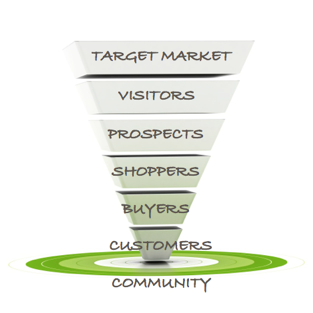Editor’s Note: This is part one of a two-part series on improving the conversion rate of an ecommerce site by managing its “sales funnel.”
An ecommerce business has a sales funnel. Business-to-business sales funnels are generally more complex than business-to-consumer ones. But the basic steps are the same, as are the supporting sales and marketing activities. Service businesses generally have a different funnel that includes more research and may not include an actual sales transaction.
This article will focus on the various activities that support a sales funnel and how to manage them to optimize your conversion rate.
A sales funnel refers to the steps involved in converting a targeted market segment into paying customers.
Step 1: Convert Target Customers to Visitors
Invest the time to identify who your target customers are and how they likely seek out the products or services that you sell. You can research this using the keyword tool within Google AdWords or other similar tools.
Once you understand your target customers, be sure your website is visible to them from search engines, affiliate sites, relevant blogs, directories, and other online sources. Your goals in this stage of the funnel are to identify your target market and drive visitors to your store. Here are a few of the marketing tools you should be using to make this happen.
- Search engine optimization. Focus on keywords likely to draw visitors to your website
- Online advertising. Includes pay-per-click ads, ads on Amazon.com, banner ads in relevant ad networks, and affiliate sites.
- Print advertising. In targeted industry publications.
- Comparison shopping engines. Support product feeds to Google Shopping, Bing Shopping, TheFind, Nextag, Shopping.com, and other comparison sites.
- Marketplaces. Sell on Amazon, Buy.com, Overstock.com, Sears.com, eBay, and others.
- Blogs. Your blog should have compelling content to attract traffic.
- Social media. Be sure you are visible in the various social media sites. They will be more important later in the funnel.
Develop content — including relevant ads — that supports your keywords and otherwise appeals to your target customer.
Step 2: Convert Visitors to Prospects
Once you get visitors to your website, you need to keep them engaged beyond the initial landing page. A prospect, to me, is someone who browses more than three pages and bookmarks your website. Here are some of the key factors to turn visitors into prospects.
- Site design. You want a visually clean site, with relevant content that’s clearly visible.
- Compelling content. Provide original, detailed descriptions of the items you sell. Don’t force visitors to leave your store for research. They likely won’t come back.
- Good navigation. Be sure you have a robust site search, hierarchical navigation, and other ways to navigate to your products.
- Security and trust. Establish trust through testimonials, security badges, and memberships. An “about us” page that includes a history of the business, its location, and identifies its management is also helpful.
- Load times. Be sure your store is fast so your visitors do not leave.
- Merchandising. Offering promotions of some type in your store is important. Be clear about what they are, but don’t let them be your entire focus. Think about them as the end cap in a grocery store. You see a few things in a product category that are appealing, but you can move past easily. Loss leaders are a good way to skip directly from visitor to shopper.
- Wish lists. This is an effective way to move someone from visitor to prospect.
- Landing pages. Use landing pages that are tightly integrated with where visitors came from and what they may have been searching for or browsing when they clicked through.
- Contact and signup points. Include obvious links to your email signup, and links to Facebook, Twitter, Pinterest, and any blogs you may support.
- Reviews. Product reviews develop trust with your visitors and demonstrate that you are transparent and open to feedback.
Your ability to turn visitors into prospects will also be assisted by your presence in social media. Many people click through to those sites to see what other people are saying about your company or products.
Step 3: Convert Prospects to Shoppers
At this stage, you are trying to get a prospect to put something in the shopping cart. Here are some of the critical elements of this stage.
- Chat and phone support. Offer a way to get immediate answers — not an email — to questions.
- Newsletters. Send initial subscribers a confirmation email. Offer them a few preference choices — topical, frequency, type ( i.e., promotions only, new items, general updates).
- Social media postings. Mix up your posts with offers, new product introductions, how-to tips, surveys, images, funny stories. Let your prospects get to know you.
- Remarketing ad campaigns. Google and other ad networks now offer ad campaigns that target visitors to your store. It’s becoming popular because it is effective in reinforcing brands and products. We’ve addressed remarketing recently at “How to Use Google’s Remarketing Platform.”
- FAQs. Be sure to have a section for frequently asked questions. This may include information about products, returns, shipping, pricing, and discounts.
- Site promotions. Offer a daily deal, free shipping, or something that creates a “buy now” impulse.





